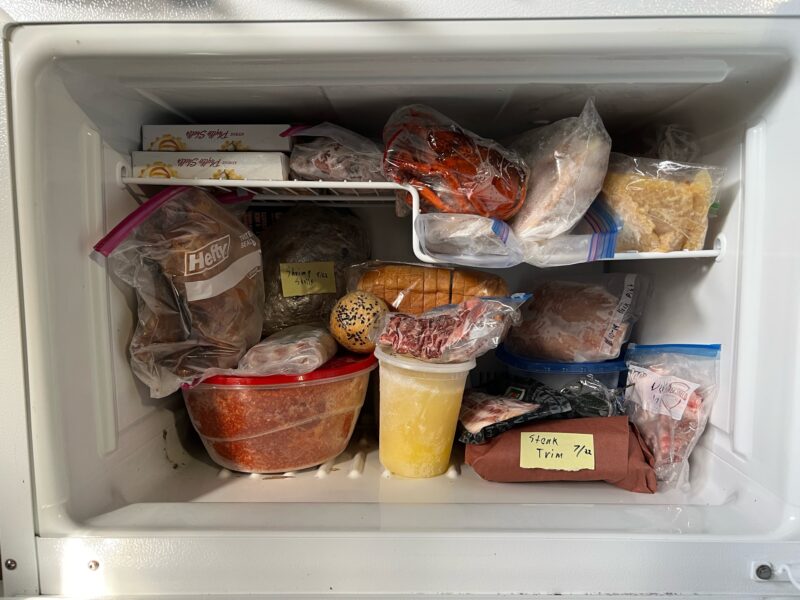

“Eat everything. Waste nothing” — Anthony Bourdain
In one of the swankiest zip codes in Manhattan, I saw a petite young woman digging through a large plastic trash bag filled with bagels. For no particular reason, except maybe poor judgment, I asked her if I could buy her some food. She politely declined. This 34-year-old, who I would later learn worked in finance, patiently explained that every night at 9 p.m. the bagel shop threw out hundreds of bagels. She had to keep working while we talked because as a longtime Upper East Sider with lots of friends, she had orders to fill. In what she called “harvesting,” she picks up bagels nightly, “The way the French buy baguettes daily.”
The movement to stop food waste has begun. And just in the nick of time.
According to the United Nations, “If food waste were a country, it would be the third highest greenhouse gas emitting nation behind the U.S. and China.” Reducing food waste is so important that Project Drawdown ranks it as the number three solution for reversing global warming, and the single most important action an individual can take at home (For context, switching to electric vehicles ranks 26th).
In the U.S., we waste more than 40 percent of the food we produce. That’s the equivalent of almost 130 billion meals’ worth of food annually, and enough calories to feed every undernourished person on the planet.
Each of us wastes an average of half a pound of food every day, except of course at Thanksgiving, which is in a league of its own. Despite surveys indicating that turkey is people’s least favorite item on the table (or perhaps because of it), we waste around 200 million pounds of turkey every holiday. Forty million pounds of mashed potatoes and 30 million pounds of stuffing will hit the trash as well.
Even if we canceled this historically dubious holiday, greenhouse gas emissions generated by food waste still account for 9 percent of total global emissions. Food production is the single biggest cause of deforestation, as well as biodiversity and habitat loss.
And yet, no matter how hard I try, I waste food.
I suffer from a profound lack of self-awareness when it comes to what’s in my pantry, how high I should fill my grocery cart, and how much I can eat. Not to mention a total brain freeze regarding how much money I’m wasting. I buy a bunch of groceries, then don’t feel like cooking. I suddenly get invited out for dinner and forget all about leftovers. Life just happens and somehow I end up with yet another rotten avocado.
And like most Americans, I believe I waste less than most Americans. Almost 76 percent of people in the U.S. think they throw away less food than their neighbors. It’s the same tendency that makes us think we’re better drivers than everyone else on the road.
Thanksgiving is a portrait of good intentions gone awry. We all want that Norman Rockwell tableau, but there should be a happy middle ground between being fully prepared for the feast and shopping for Armageddon.
Shop your fridge first. Take inventory. Or take “shelfies” instead (Yes, that’s a thing). You may already have brown sugar and marshmallows from last year’s meal.
Nowadays, you can google your way out of wasting food. Plug in random items and somebody online will have a recipe for it. I typed in maraschino cherries and green olives just to put it to the test. Now I have an amazing bacon appetizer for the holidays.
Never shop hungry. Stick to your list. And try not to fall into the Costco syndrome — buying too much because it’s a great deal. Can you really, really finish that entire wheel of cheese? (Don’t answer that).
Shop for the number of people you expect at Thanksgiving, and then cut the amount by a third. For turkey, plan for one pound per person. With small gatherings, consider serving one pie instead of the usual trifecta of pumpkin, pecan and apple.
Store food properly. With wall-to-wall containers of unidentified sitting objects, a refrigerator can become a black hole of food waste. Use the “first in, first out” method, placing the newer package behind the older one. If a head of lettuce lasts no longer than a British prime minister, put it in front.
Befriend your freezer and visit it often. The freezer is a lazy cook’s best friend. As a way station for bread, nuts and seeds, meat and bananas on the edge. Nothing goes bad if it gets to the freezer in time.
Our reverence for complicated expiration dates also leads to huge amounts of waste. “Use-by” is the only useful date to follow. The others are recommendations for flavor and quality, but often don’t make sense. Honey has a “best by” date even though it never goes bad. Even the humble water bottle has an expiration date.
Use the whole plant. Or as much of it as you can. Eat the yolk. Turn sweet potatoes into potato fries. Throw slightly wilted veggies and fruit into the blender instead of your disposal. Parsley stems taste the same as a parsley leaf in a blender. Fruits that are overly ripe still taste great in smoothies. Coffee grounds, probably the one food you can’t repurpose, make excellent plant fertilizer.
Use the whole animal. Turkey bones make turkey stock. A pot of turkey chili lasts for weeks. Local chef Jason Casey likes using ham hocks to give stew a rich, smoky flavor. “The only part of the pig you can’t eat is the oink,” he says.
Soup is the original landing pad for food that’s on the edge — wilted veggies or herbs, cheese rinds and food that you’ve saved by freezing which is too blobby and shapeless to serve. In Italy, they take the concept of whole food cooking to the next level and use tomato stems to enhance the flavor in tomato soup.
Once you’ve used the plant every conceivable way, composting should be the last resort. Turning food waste into compost diverts it from the landfill, but solves only a small part of the problem. Uneaten food squanders a whole host of resources: seed, fertilizer, water, land, labor and the fuel it took to grow, harvest and package, transport and finally cook, all of which generates massive amounts of greenhouse gas emissions.
Wasting food these days also means wasting a lot of money.
“Today, even cheap food is getting expensive!” says cookbook author Hillary Davis. “I used to use chicken wings to make broth because they were so cheap. Now they’re almost four times the price at King Kullen.”
The price of a Big Mac in Southampton just hit $6.83. A glass of chardonnay at a restaurant sets you back $20. According to U.S. Bureau of Labor statistics, food prices rose 13.5 percent in the last year, the largest 12-month increase since 1979. Pick the bones of this year’s turkey clean because the average retail price for a frozen turkey has jumped 73 percent since 2021, according to the Department of Agriculture.
The great irony is that the waste we create now will cost us even more later. Wasted food contributes to climate change, which causes drought, which make it harder to grow food, causing higher food prices, which then will finally force us to waste much less food.
Buy what you need. Eat what you buy. Keep food fresh. Or freeze it. And whatever else you do, be thankful for it.
Save The Food (savethefood.com): Easy to navigate tool to help make perfectly portioned meals, learn storage tips and tricks to revive food. Stale bread? Milk on the brink? They have it all.
The Guest-imator (at savethefood.com): My favorite tool — a dinner party calculator that estimates how much food you need to keep guests happy.
Your Plan, Your Planet (yourplanyourplanet.sustainability.google): Helps you toss less and save more plus make food last longer. Test your assumptions with fun guessing games.
Hungry Harvest (hungryharvest.net): Help cut food waste globally while saving money. Delivers “rescued” food that’s still perfectly good as well as a huge variety of non-perishables.
 More Posts from Jenny Noble
More Posts from Jenny Noble